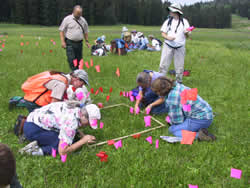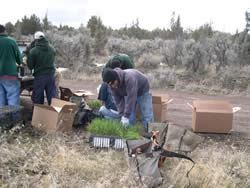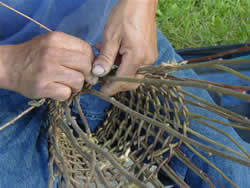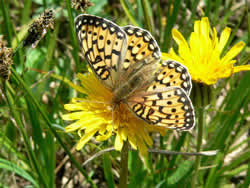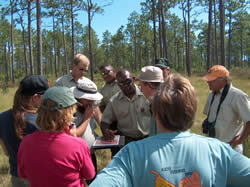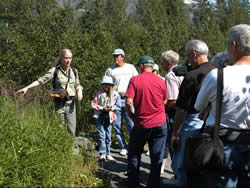USDA Forest Service Celebrating Wildflowers
|
|
|
About Us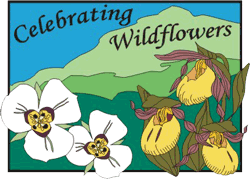 The Celebrating Wildflowers WebsiteUSDA Forest Service botanists and other specialists around the country have contributed to the editing, content, construction, and maintenance of this website. The site is dedicated to the enjoyment of the thousands of wildflowers growing on our national forests and grasslands, and to educating the public about the many values of native plants. We hope you enjoy the website and come back to visit often! The Celebrating Wildflowers ProgramThe USDA Forest Service started the Celebrating Wildflowers program in 1991. The program responds to public desire for information about native plants and their conservation. It is a way to promote and enjoy wildflowers on the 191 million acres of national forests and grasslands. The Bureau of Land Management, which manages 270 million acres of public lands, joined the program in 1994. Together, the two agencies now promote wildflower programs on about 20 percent of the nation’s landmass. The U.S. Fish and Wildlife Service, National Park Service, and USDA Agricultural Research Service have also joined the program. In addition, groups like, garden clubs, botanical gardens, Native Plant Society chapters, nurseries, universities, and public schools actively participate in Celebrating Wildflowers. The Forest Service Botany Program
Within this website, we have also posted information on other aspects of the Forest Service Botany Program. Over 220 botanists and numerous plant ecologists as well as other specialists administer the various programs of the botany program on our nation’s national forests and grasslands. Rare PlantsOne of the agency’s important activities is the conservation and management of rare plants. The rare plants program includes plants listed as threatened, endangered, or proposed under the Endangered Species Act. Additionally, each Regional Forester designates other rare plant species as sensitive under the Forest Service’s sensitive species program. Under the new planning rule, Forest Supervisors designate rare plants as species of concern or species of interest. Botanists inventory and monitor rare plants and the plant communities they depend upon. They prepare conservation assessments, conservation strategies and biological assessments. In addition, they prepare management prescriptions to conserve, recover, and protect these rare species. Vegetation InventoriesBotanists, plant ecologists, rangeland conservationists and other resource specialists work together to delineate, inventory, map, and monitor various types of vegetation. Besides the more common vegetation types, they identify, manage and conserve rare plant communities such as fens and bogs, barrens, rock outcrop communities, and rare plant habitats
Native Plant MaterialsThis past summer , the Forest Service published a proposed native plant materials policy (PDF) in the Federal Register (PDF) requesting comments from the public. This new policy will increase the production and use of native plant materials in restoration, revegetation, and rehabilitation projects on the lands managed by the Forest Service. The comment period closed on August 24, 2006. The forest Service is now reviewing the comments and will issue a revised policy in the next 3 to 6 months. Many activities can alter natural ecosystems to a point where it is necessary to implement revegetation, rehabilitation, or restoration projects. Botanists, plant geneticists, plant ecologists and other resource specialists are spearheading the selection and development of native species plant materials such as seed, plugs, and tree and shrub seedlings. This work requires scientific skills in plant genetics and ecology in order to determine appropriate plant selection, collection techniques of seed or vegetative materials, propagation, propagules storage, and planting methodologies.
EthnobotanyThe botany program provides leadership in the conservation and management of ethnobotanical resources. Ethnobotanical resources are plants that are important to people and society in everyday life. Examples of ethnobotanical resources include the conservation of genetic resources of wild species from which crop plants such as peppers, cranberries and sunflowers have been developed. Other examples include food plants such as huckleberries, mushrooms, fruits and nuts, medicinal plants, dye plants, resins, waxes, latexes and ornamentals just to mention a few. PollinationThe management of pollinators on the national forests and grasslands is an important aspect of the botany program. Over 80% of flowering plants require pollination by animals to successfully to reproduce and produce seeds and fruits. Plants and pollinators together provide the basis for life by converting the sunlight into food, materials for shelter, clean air, clean water, medicines, and other necessities of life.
PartnershipsPartnerships are an invaluable resource in delivering the botany program on the national forests. We work with many others to conserve and manage our forest and grassland resources, such as The Nature Conservancy, NatureServe, Center for Plant Conservation, Society for Ecological Restoration, Natural Areas Association, North American Pollinator Protection Campaign, Garden Club of America, Plant Conservation Alliance, Bat Conservation International, sister federal agencies (Bureau of Land Management, Natural Resource Conservation Service, Fish and Wildlife Service and others), States, Tribes, and universities. Invasive Plant Management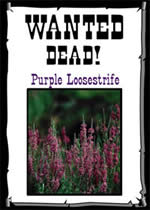 An invasive species is defined as a species, including its seed, spores, or other biological material, whose introduction causes or is likely to cause economic or environmental harm or harm to human health. Most of these plants were introduced from other continents, either accidentally or on purpose and arrived without the predators and diseases that keep them in check in their native habitats. Many invasive plants have the potential to spread very rapidly displacing native plants and severely impacting native plant communities. Forest Service botanists, plant ecologists, rangeland conservationists and other resource specialists are managing invasive plants through programs designed to prevent introductions, to detect introductions early and respond rapidly, to control, manage, and where possible, eliminate established infestations and to reintroduce native plants to restore the vegetation. Information and Education
Through our Celebrating Wildflowers program Forest Service personnel and our partners and volunteers present informative talks, lead wildflower hikes, staff displays at public events such as flower and garden shows, write wildflower articles for the popular media, and prepare and produce educational materials. Botanists often instruct courses for other Forest Service staff, federal and state agency personnel and the public on plant identification, plant ecology and other topics like native plant gardening and landscaping, plant pollination, and medicinal plants. Many of our botanists and plant ecologists prepare articles to be published in peer reviewed scientific journals, give oral presentations, and prepare scientific posters of projects at scientific meetings. |
|
| NOTE: PDF format links require the Adobe Acrobat Reader to view. | |
| top | Disclaimers | FOIA | Privacy Policy | Quality of Information | Photo Credits & Use |
Location: http://www.fs.fed.us/wildflowers/aboutus.shtml
Last modified: Tuesday, 24-Jun-2008 21:59:01 EDT
